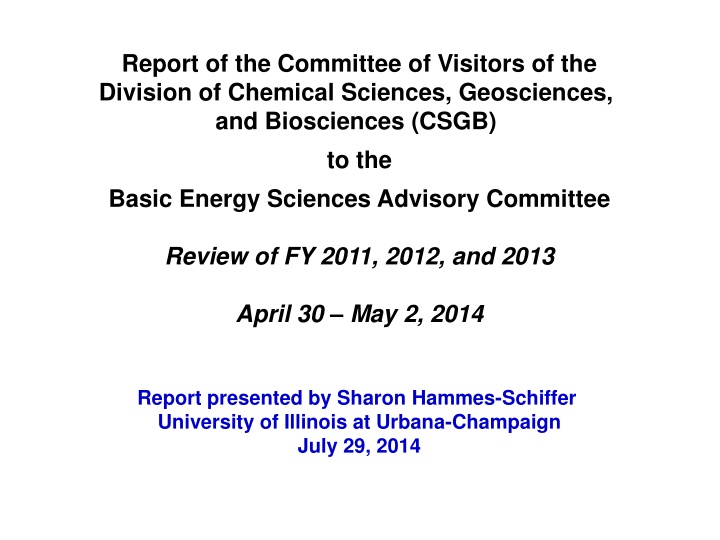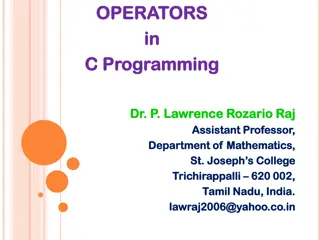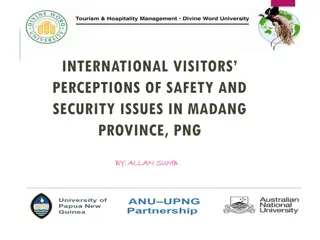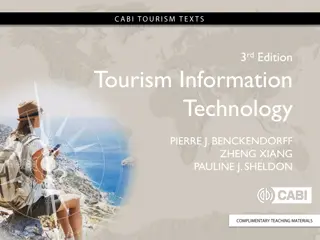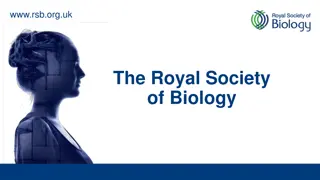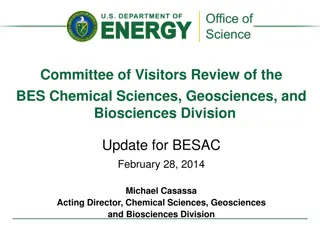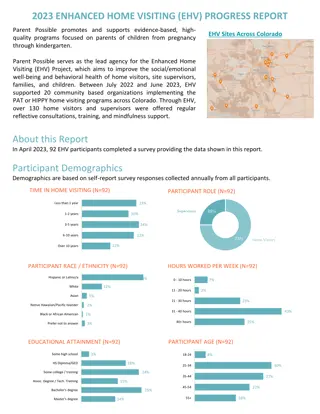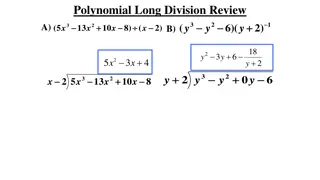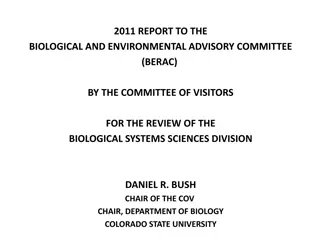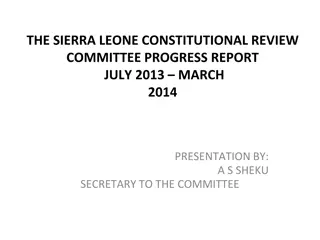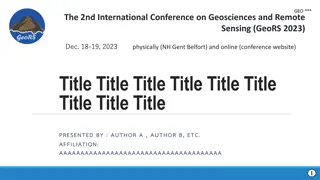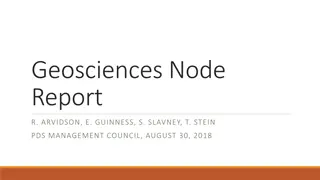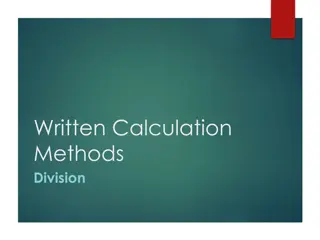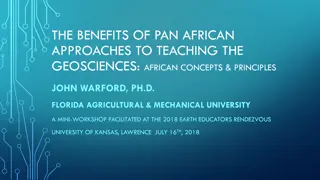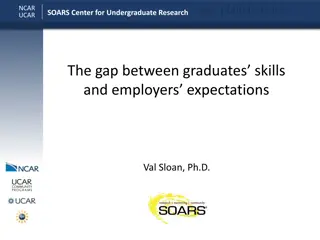Report of Committee of Visitors - Division of Chemical Sciences, Geosciences, and Biosciences Review FY 2011-2013
Report presented by Sharon Hammes-Schiffer on the operations of CSGB Division for FY 2011-2013, addressing both DOE Lab and university projects. It assesses proposal processes, project monitoring, and impact on portfolio elements within DOE missions. Three panels cover various scientific areas, with 17 expert panel members evaluating different aspects of chemical sciences, geosciences, and biosciences.
Download Presentation

Please find below an Image/Link to download the presentation.
The content on the website is provided AS IS for your information and personal use only. It may not be sold, licensed, or shared on other websites without obtaining consent from the author.If you encounter any issues during the download, it is possible that the publisher has removed the file from their server.
You are allowed to download the files provided on this website for personal or commercial use, subject to the condition that they are used lawfully. All files are the property of their respective owners.
The content on the website is provided AS IS for your information and personal use only. It may not be sold, licensed, or shared on other websites without obtaining consent from the author.
E N D
Presentation Transcript
Report of the Committee of Visitors of the Division of Chemical Sciences, Geosciences, and Biosciences (CSGB) to the Basic Energy Sciences Advisory Committee Review of FY 2011, 2012, and 2013 April 30 May 2, 2014 Report presented by Sharon Hammes-Schiffer University of Illinois at Urbana-Champaign July 29, 2014
Charge for the COV Charge: address operations of CSGB Division for FY 2011-2013 For both DOE Lab projects and university projects, assess the efficacy and quality of the processes used to: (a) solicit, review, recommend, and document proposal actions (b) monitor active projects and programs Within the boundaries defined by DOE missions and available funding, comment on how the award process has affected: (a) breadth and depth of portfolio elements (b) national and international standing of portfolio elements not included: EFRCs, Fuels from Sunlight Energy Innovation Hub, Office of Science Early Career Program
Three Panels Panel 1: Fundamental Interactions Atomic, Molecular, and Optical Sciences Gas Phase Chemical Physics Condensed Phase and Interfacial Molecular Science Computational and Theoretical Chemistry Panel 2: Photochemistry and Biochemistry Solar Photochemistry Photosynthetic Systems Physical Biosciences Panel 3: Chemical Transformations Catalysis Science Separations and Analysis Heavy Element Chemistry Geosciences
Panel Membership: 17 Members Sharon Hammes-Schiffer, COV Chair, University of Illinois (BESAC, COV 2008, 2013*) Panel 1: Fundamental Interactions Bruce Kay, Panel Lead, PNNL (BESAC, COV 2005) Heather Lewandowski, JILA/University of Colorado Giulia Galli, University of Chicago Gilbert Nathanson, University of Wisconsin Rigoberto Hernandez, Georgia Tech Panel 2: Photochemistry and Biochemistry Jim McCusker, Panel Lead, Michigan State University (COV 2013*) Greg Scholes, University of Toronto Claudia Turro, Ohio State University Lisa Utschig, Argonne National Lab Joan Broderick, Montana State University *COV 2013 evaluated EFRCs and JCAP Hub, not CSGB COV
Panel Membership and Process Panel 3: Chemical Transformations Nick Winograd, Panel Lead, Penn State University (COV 2005) Jim Rustad, Corning Nicholas Delgass, Purdue University Emily Smith, Iowa State University James Boncella, LANL Anne Chaka, PNNL (COV 2005, 2011) Panel Balance: funded by BES / not funded by BES: 10 / 7 academic / national lab / industrial: 12 / 4 / 1 Process: - Information provided on CSGB COV website, initial conference call - COV began with overviews of charge, review procedures, and programs - First and second readings of folders, many discussions - Reconvened and finalized findings and recommendations
Major Findings 1. The COV finds the processes of solicitation, review, documentation, and monitoring of proposals to be outstanding. The reviewing process is comprehensive and thoughtful, and the use of both mail reviews and panel reviews is viewed favorably. The Program Managers are to be commended for their dedication, professionalism, and effectiveness. 2. The COV judges the breadth and depth of the portfolio elements, as well as the quality of the science and principal investigators, to be excellent. The Program Managers have successfully balanced the mission-oriented nature of the DOE with the flexibility required for high-quality scientific research. The portfolios include many senior scientists who are highly respected at the international level, as well as more junior scientists with promising career trajectories.
Major Findings (Cont.) 3. The practice of encouraging preliminary statements of potential research projects, that is, white papers, with feedback by the Program Managers is viewed favorably. This practice allows helpful, rapid communication between the Program Manager and the potential principal investigator prior to submission of a full proposal. Such feedback discourages scientists from spending time preparing proposals that are not within the programmatic scope and provides guidance as to how scientists can refine their proposals to be more suitable for the BES mission. 4. The COV is pleased that the PAMS has been initiated, although the full implementation is not yet complete. The full implementation will provide useful quantitative information about demographics and review procedures.
Major Recommendations 1. The COV strongly recommends a substantial increase in the funding provided to Program Officers to travel to national and international conferences, as well as to visit the laboratories of researchers in their programs. Attending conferences will enable the Program Managers to identify cutting-edge areas of research and promising researchers and to transmit the BES program message to a broader audience. Visiting the laboratories of principal investigators will allow the Program Managers to maintain closer contact with these researchers and to discuss new research directions within their programs. Overall, increased travel is expected to broaden participation in the BES programs and ensure that the research remains at the forefront of the fields.
Major Recommendations (Cont.) 2. The COV recommends the continued use of white papers as a mechanism for Program Managers to interact with potential principal investigators prior to the submission of proposals. This practice allows Program Managers to encourage researchers to submit a full proposal, to modify their research directions to be in accordance with programmatic considerations, or to consider alternative funding options if the topic is not aligned with the BES mission. 3. Although the development of the PAMS is viewed favorably, the COV recommends that the full implementation of this system be completed as soon as possible to allow analysis of data that are directly relevant to the BES programs. Such data will be critical for determining how the reviewing process could be improved and in which directions participation could be broadened.
Major Recommendations (Cont.) 4. The COV recommends that BES execute a strategic planning session at the division level to evaluate current directions and identify new opportunities and synergies. This type of strategic planning will facilitate communication and collaboration among the programs and will encourage the Program Managers to develop their portfolios in a consistent and cooperative manner. A clarification of the objectives and vision of the CSGB Division, as well as the individual programs, will also be helpful to potential principal investigators submitting proposals. Strategic planning should be an ongoing exercise at both the team level and the division level and should involve input from the community and principal investigators as well as guidance from external sources such as BESAC reports.
Other Comments and Suggestions 1. For site reviews of proposals from national laboratories, the reviewers are given clear instructions about the review criteria, but this is not always the case for mail reviews of these proposals. The COV suggests that the mail reviewers be sent clear instructions about the review criteria, such as the emphasis on synergy, for these types of proposals. 2. The balance of funding between proposals with a single principal investigator and those with multiple principal investigators is of interest to the community. A comparison of the productivity from these two types of grants would be helpful in the evaluation of this balance, although the quantification of productivity and the measurement of synergy in multiple principal investigator grants is challenging.
Other Comments and Suggestions 3. While the practice of using white papers is highly commended, this practice leads to higher apparent acceptance rates because some proposals are discouraged prior to submission. The documentation of when white papers are used would provide more relevant statistics about acceptance rates. The COV recognizes that the documentation of the details of the white paper process would be burdensome and does not consider such detailed documentation to be necessary. 4. The COV encourages further documentation of collaborations and interactions between programs. This documentation would enable BES to highlight this positive aspect.
Relation to 2011 COV 2011 COV Recommendations and Suggestion: 1. Program managers encouraged to attend conferences. 2. Program managers encouraged to continue practice of considering preliminary proposals with rapid evaluations. 3. BES encouraged to provide more accessible web sites. 4. PAMS system is essential and should be developed promptly.* Response: BES concurred with the three recommendations and agreed to implement them within budgetary constraints. Three out of four 2014 COV Recommendations/Suggestion were in the 2011 COV report and have been addressed by BES but continue to be significant issues. The fourth 2014 COV Recommendation of a strategic planning session at the Division level is new. *Listed as a Comment and Suggestion rather than a Recommendation
Many Thanks! Harriet Kung, Associate Director of Science for BES John Miller, Previous Acting Director of CSGB Michael Casassa, Acting Director of CSGB John Hemminger, Chair of BESAC Outstanding BES Program Managers and Staff! Diane Marceau Terrific COV Members!
